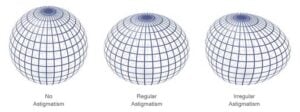Astigmatism is a common eye condition that changes how your eye perceives light. For people with untreated astigmatism, lights that are meant to be helpful can be dangerous, especially when driving at night.
Traffic lights, headlights, and even reflective street signs can appear distorted and distracting. This article explains how astigmatism affects how you see lights and provides tips for safe night driving.
How Do Lights Look With Astigmatism?
Astigmatism may distort the appearance of lights. Visual distortions caused by astigmatism include:
- Blurriness
- Glare
- Streaking
- Starburst
- Halo effect
Here are some examples of how lights may look with astigmatism:



Glares or a halo appearance around lights do not necessarily indicate astigmatism. This can also be caused by other vision conditions, like nearsightedness (myopia) or cataracts.
How Does Astigmatism Affect Night Driving & Vision?
Astigmatism can impair vision at night and make driving difficult. People with astigmatism may notice:
- Blurring or fuzziness around lights and other objects
- Halos around lights
- Lights appearing ‘streaky’
- Increased glare from lights
- Increased squinting to see more clearly
Driving at night with untreated astigmatism can be dangerous. Streetlights and headlights can also look distorted, increasing the chance of an accident. If you have trouble with your night vision or notice any of these symptoms, immediately schedule an exam with your eye doctor.
Tips for Driving at Night with Astigmatism
The best way to reduce light distortions from night driving is to address your underlying astigmatism. Your eye doctor can recommend the most appropriate solution for you.
Depending on your needs, this may include:
Eyeglasses
Prescription eyeglasses can correct your astigmatism. Glasses can also treat other vision issues, such as nearsightedness or farsightedness. An anti-reflective on the lenses will help reduce streaks and blurriness around lights at night.
Contact Lenses
Contacts are corrective lenses that sit directly on your eye. Your doctor may recommend toric contact lenses to help your night driving with astigmatism.
Orthokeratology
Also known as ortho-k, this treatment involves wearing special contact lenses overnight. The rigid contact lenses temporarily reshape your corneas while you sleep.
Surgical Treatments
Eye surgeries that correct astigmatism include:
- LASIK: A highly successful laser eye surgery involves making a flap in your cornea before your eye surgeon reshapes the corneal tissue
- PRK: Like LASIK, this laser eye surgery corrects astigmatism by reshaping your cornea; the procedure doesn’t use a corneal flap.
- Toric lens implant: People who need cataract surgery may receive a toric lens implant which corrects your eye’s shape
Other Eye Care Tips
Your doctor may recommend additional eye care tips you can use at home. Depending on your eye health, these may include:
- Use eye drops to relieve dry eye
- Keep your eyeglass lenses clean
Avoid wearing night driving glasses with yellow-tinted lenses. A 2019 study shows that these glasses don’t improve the ability to see at night.8
Driving Habits to Help Night Vision
Techniques to improve your night driving include:
- Keep your windshield clean
- Use the night setting on your rearview mirror
- Dim your car’s display lights
What is Astigmatism?
Astigmatism is a common and treatable eye problem that causes blurry or distorted vision. In the United States, one in every three people has astigmatism.4
Astigmatism occurs when your cornea or lens curvature is abnormal. This causes blurred vision at all distances.
The two types of astigmatism are:
- Corneal astigmatism: The cornea is more oval-shaped than round
- Lenticular astigmatism: The lens is misshapen
In a normal eye, each of these elements is almost perfectly round.

An irregular cornea or lens prevents the eye from focusing light rays correctly on the retina. The area in the eye converts light into signals sent to the brain for visual recognition. Astigmatism occurs naturally or is caused by an eye injury, eye disease, or eye surgery.
Symptoms of Astigmatism
The most common symptoms of astigmatism are:
- Blurry vision
- Needing to squint to see clearly
- Headaches
- Eyestrain
- Difficulty seeing at night
If you have mild astigmatism, you might not notice any symptoms. That’s why it’s essential to get regular eye exams.
An optometrist or ophthalmologist can diagnose astigmatism even if you don’t notice it. All children should visit a pediatric optometrist at least once a year.
How is Astigmatism Diagnosed?
An optometrist can diagnose astigmatism during a regular eye exam.

A typical eye exam includes:
- A visual acuity test to check the ability to discern shapes and details
- A refraction to determine your refractive error (including astigmatism), which the doctor bases your eyeglass prescription on the results of this test
- A visual field test to check the peripheral (side) vision
- An eye muscle function test to check for issues with the muscles around the eyeballs
- A pupil response test to check how your pupils respond to light and viewing near objects
- A tonometry test to measure eye pressure
- Dilation to check for problems with the inner parts of the eyes
Treatment for Astigmatism
Many treatment options are available to help you see better. The most common treatments include:
- Eyeglasses for astigmatism
- Contact lenses for astigmatism
- LASIK surgery for astigmatism
- Astigmatic Keratotomy
- Orthokeratology
- PRK (photorefractive keratectomy)
- A toric lens implant
If you have glasses or contacts for astigmatism, wear them when driving at night. If you still have trouble with night vision, see your eye doctor. You may need to have your prescription adjusted or find an underlying cause.
Summary
Astigmatism is a common and treatable condition that prevents light from going into your retina properly. It causes bright visual distortions that look like halos, streaks, and starbursts.
Driving at night with untreated astigmatism can be difficult and even dangerous. This is because the visual effects around various light sources can be distracting and confusing.
Fortunately, there are ways to help you drive at night with astigmatism. An eye doctor can also diagnose nad treat your astigmatism so you can see clearly while driving at night.
In this article






